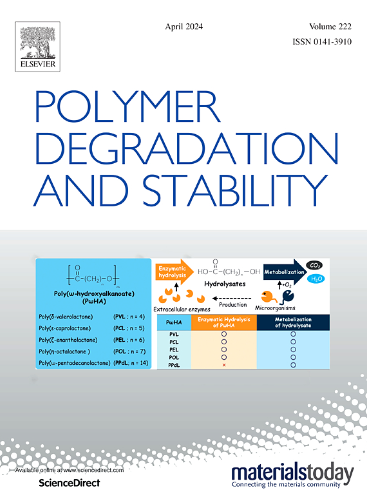Effect of different structured epoxy-type reactive rejuvenators on recycling performance and repair mechanism of the aged styrene-butadiene-styrene (SBS) modified bitumen
IF 6.3
2区 化学
Q1 POLYMER SCIENCE
引用次数: 0
Abstract
The styrene-butadiene-styrene (SBS) modified bitumen (SMB) has gained worldwide popularity due to its exceptional performance. However, the waste SMB generated by its maintenance and resurfacing urgently needs to be rejuvenated with good performance for the prolonged service life of asphalt roads. In this study, the epoxy-type reactive rejuvenators, trimethylmethylpropane triglycidyl ether (TMPTE) and polyethylene glycol diglycidyl ether (PEGDGE), combined with vegetable oil (VO) were employed to reconstruct the aged SBS modified bitumen. Mild-moderate thermo-oxidative aging and pressure aging methods were applied, and regeneration experiments were conducted subsequently. FTIR indicates the occurrence of the SBS repair reaction or/and epoxy homo-polymerization. GPC demonstrates the restoration of characteristic peaks for both SBS and bitumen in aged SMB after the regeneration, while FM images show a reconstructed network structure of SBS. From a macroscopic perspective, the regeneration of aged SMB was assessed from four aspects, i.e. high/low temperature performance, elasticity and stiffness. It is found that the PEGDGE regenerated SMB exhibits the best high-temperature performance in the thermo-oxidative aging system, while the TMPTE regenerated SMB demonstrates the best high-temperature performance in the pressure aging system. And TMPTE regenerated SMB exhibits the best low temperature performance and elasticity in the thermo-oxidative aging system, and PEGDGE regenerated SMB exhibits the excellent low temperature performance and recovery performance in the pressure aging system. Meanwhile, in the thermo-oxidative aging system, PEGDGE regenerated SMB demonstrates superior deformation resistance. In the pressure-aging system, TMPTE regenerated SMB exhibits exceptional deformation resistance. The mechanism for the varying regeneration effects of different aging methods and regeneration systems were analyzed, suggesting a possible correlation with the molecular structures (e.g. functionality, chain flexibility) of the epoxy-type reactive rejuvenators. This study offers a theoretical guidance for regenerating aged SMB pavements with varying degrees of aging and a reference for selection or synthesis of reactive rejuvenators.
不同结构环氧型活性再生剂对老化SBS改性沥青回收性能及修复机理的影响
苯乙烯-丁二烯-苯乙烯(SBS)改性沥青(SMB)以其优异的性能得到了广泛的应用。然而,为了延长沥青路面的使用寿命,沥青路面在养护和重铺过程中产生的废SMB急需进行性能优良的再生处理。本研究采用环氧型活性恢复剂三甲基甲基丙烷三缩水甘油酯醚(TMPTE)和聚乙二醇二缩水甘油酯醚(PEGDGE)与植物油(VO)联合对SBS老化改性沥青进行了重建。采用中轻热氧化老化和压力老化方法,并进行再生实验。FTIR显示SBS修复反应或/和环氧树脂均聚反应的发生。GPC图像显示再生后老化SMB中SBS和沥青的特征峰都得到了恢复,而FM图像显示SBS的网络结构得到了重建。宏观上,从高低温性能、弹性和刚度四个方面对老化SMB的再生进行评价。结果表明,PEGDGE再生SMB在热氧化老化体系中表现出最好的高温性能,而TMPTE再生SMB在压力老化体系中表现出最好的高温性能。TMPTE再生SMB在热氧化老化体系中表现出最佳的低温性能和弹性,PEGDGE再生SMB在压力老化体系中表现出优异的低温性能和恢复性能。同时,在热氧化老化体系中,PEGDGE再生的SMB表现出优异的抗变形性能。在压力老化系统中,TMPTE再生的SMB表现出优异的抗变形能力。分析了不同老化方法和再生体系的再生效果差异的机理,认为这可能与环氧型反应性再生剂的分子结构(如功能、链柔韧性)有关。本研究为不同程度老化的SMB路面的再生提供了理论指导,并为活性返老还老剂的选择或合成提供了参考。
本文章由计算机程序翻译,如有差异,请以英文原文为准。
求助全文
约1分钟内获得全文
求助全文
来源期刊

Polymer Degradation and Stability
化学-高分子科学
CiteScore
10.10
自引率
10.20%
发文量
325
审稿时长
23 days
期刊介绍:
Polymer Degradation and Stability deals with the degradation reactions and their control which are a major preoccupation of practitioners of the many and diverse aspects of modern polymer technology.
Deteriorative reactions occur during processing, when polymers are subjected to heat, oxygen and mechanical stress, and during the useful life of the materials when oxygen and sunlight are the most important degradative agencies. In more specialised applications, degradation may be induced by high energy radiation, ozone, atmospheric pollutants, mechanical stress, biological action, hydrolysis and many other influences. The mechanisms of these reactions and stabilisation processes must be understood if the technology and application of polymers are to continue to advance. The reporting of investigations of this kind is therefore a major function of this journal.
However there are also new developments in polymer technology in which degradation processes find positive applications. For example, photodegradable plastics are now available, the recycling of polymeric products will become increasingly important, degradation and combustion studies are involved in the definition of the fire hazards which are associated with polymeric materials and the microelectronics industry is vitally dependent upon polymer degradation in the manufacture of its circuitry. Polymer properties may also be improved by processes like curing and grafting, the chemistry of which can be closely related to that which causes physical deterioration in other circumstances.
 求助内容:
求助内容: 应助结果提醒方式:
应助结果提醒方式:


